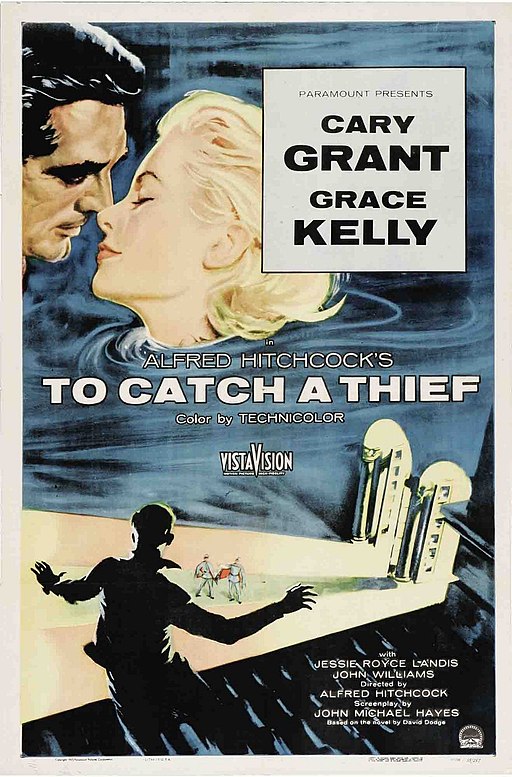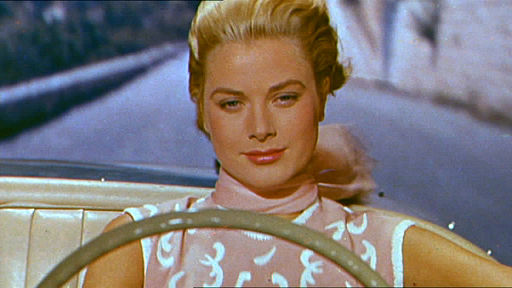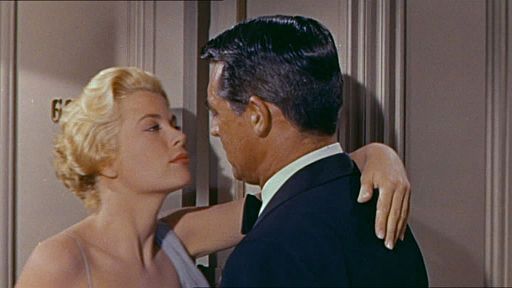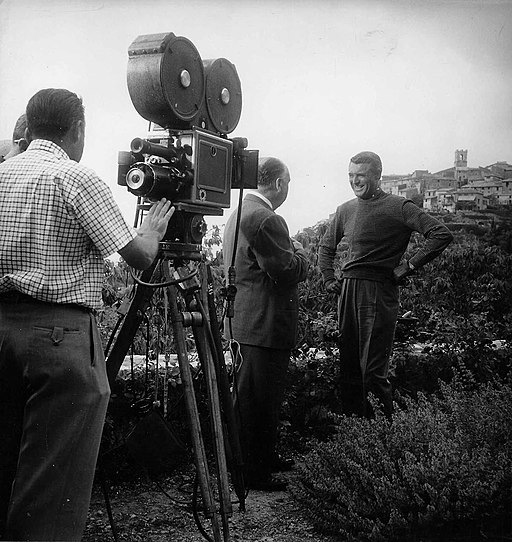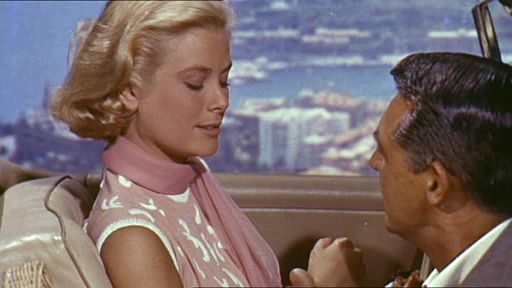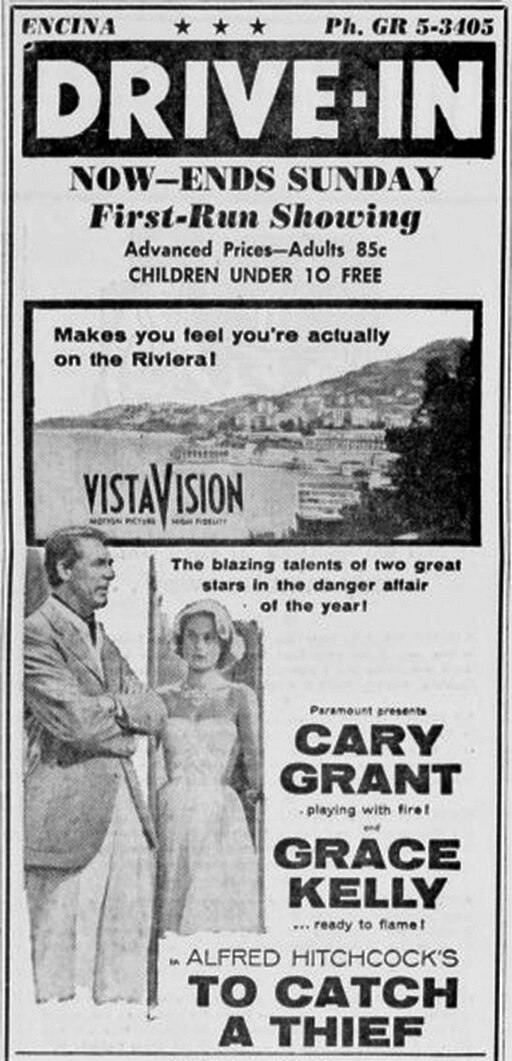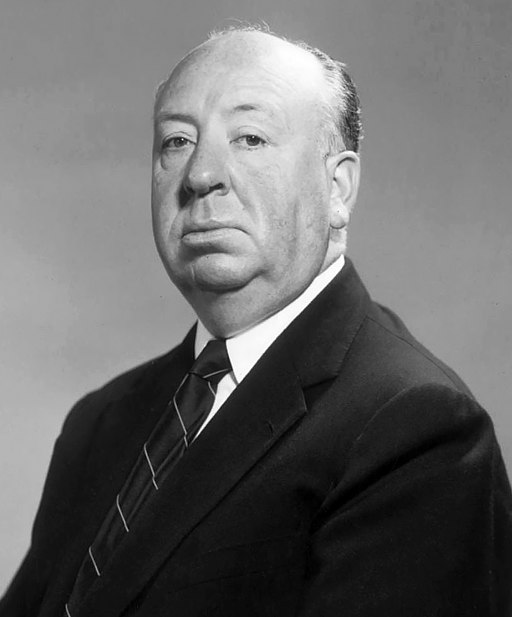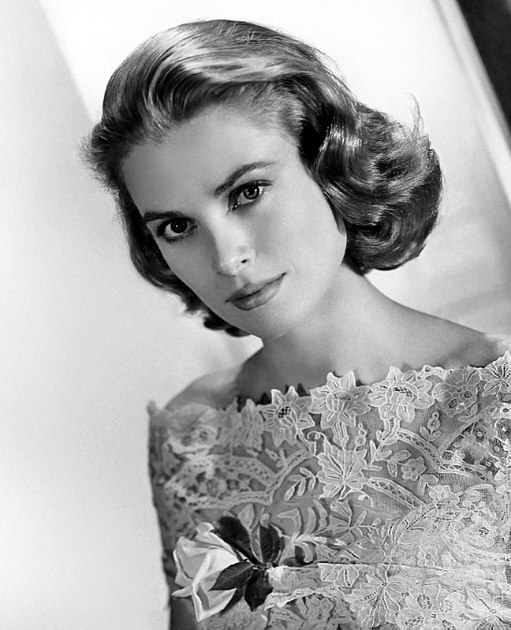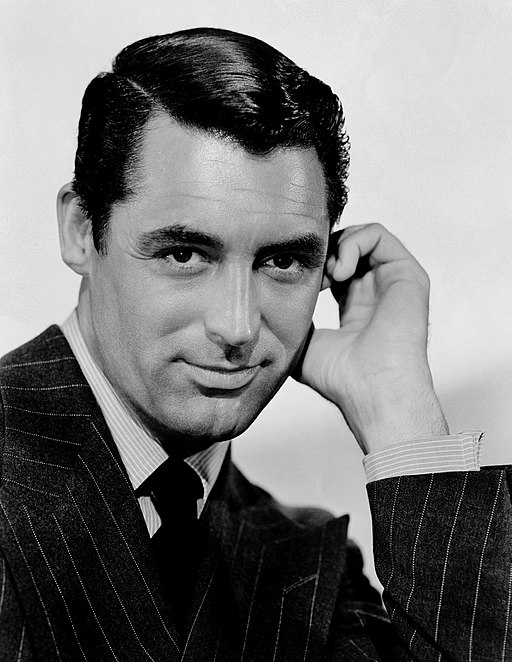To Catch a Thief - 1955
back| Released by | Paramount Pictures |
| Director | Alfred Hitchcock |
| Producer | Alfred Hitchcock |
| Script | John Michael Hayes, based on the 1952 novel of the same name by David Dodge. |
| Cinematography | Robert Burks |
| Music by | Lyn Murray |
| Running time | 106 minutes |
| Film budget | $ 2.5 million |
| Box office sales | $ 8,75 million |
| Main cast | Cary Grant - Grace Kelly - Jessie Royce Landis - John Williams - Charles Vanel |
To Catch a Thief
Elegant romantic thriller with a Hitchcockian twist
"To Catch a Thief," directed by Alfred Hitchcock in 1955, is a stylish romantic thriller set against the lush backdrop of the French Riviera.
The film follows John Robie (Cary Grant), a retired jewel thief known as "The Cat," who seeks to prove his innocence when a series of robberies mimicking his style implicates him. He becomes entangled with the affluent Frances Stevens (Grace Kelly), creating a blend of suspense, romance, and wit.
Notable for its stunning cinematography, elegant costume design by Edith Head, and the iconic chemistry between Grant and Kelly, the film is a quintessential example of Hitchcock's mastery in blending genres. Its impact lies in its visual storytelling and character development, cementing its status as a classic in Hitchcock's illustrious career and influencing the romantic thriller genre.
Related
To Catch a Thief – 1955
Summary and Analysis
"To Catch a Thief," directed by Alfred Hitchcock, is a romantic thriller set against the opulent backdrop of the French Riviera. The story revolves around John Robie (Cary Grant), a retired and reformed jewel thief once known as "The Cat." Robie's peaceful life in the French countryside is disrupted when a series of jewel thefts resembling his former style occur. To clear his name, Robie must catch the new thief.
Robie's quest leads him to the wealthy and vivacious Frances Stevens (Grace Kelly) and her mother Jessie (Jessie Royce Landis). Frances, a sophisticated American heiress, is both intrigued and attracted by Robie's charm and his mysterious past. As Robie tries to unmask the new thief, he navigates a complex web of suspicion, romance, and intrigue.
The film culminates in a lavish costume ball, where Robie sets a trap to catch the real thief. The climax reveals that the thief is actually Danielle Foussard (Brigitte Auber), the daughter of one of Robie's old associates. Robie's name is cleared, and the film ends with the promise of a future between him and Frances.
Analysis
"To Catch a Thief" is a quintessential Hitchcock film, blending suspense, romance, and humor. The film showcases Hitchcock's mastery in building tension and his penchant for visual storytelling. The use of vibrant Technicolor and the scenic French Riviera setting adds a layer of glamour and luxury, contrasting with the film's underlying theme of deception and crime.
Cary Grant's portrayal of John Robie is charismatic and suave, embodying the archetype of a gentleman thief. Grace Kelly, in one of her most iconic roles, brings elegance and a sharp wit to her character, Frances. Their on-screen chemistry is palpable, adding depth to the romantic subplot.
Hitchcock's direction is sophisticated, using clever camera angles and editing to create suspense and surprise. The film is less about the action of the thefts and more about the psychological interplay between characters, a hallmark of Hitchcock's style.
The film also explores themes of identity and trust. Robie, despite having left his criminal past, finds himself judged by it. His struggle to prove his innocence is as much about reclaiming his identity as it is about escaping the law. Frances's evolution from suspicion to trust mirrors the audience's journey as they unravel the mystery alongside the characters.
Official Trailer "To Catch a Thief":
Full Cast of “To Catch a Thief”:
- Cary Grant as John Robie ("The Cat")
- Grace Kelly as Frances Stevens
- Jessie Royce Landis as Jessie Stevens
- John Williams as H.H. Hughson
- Charles Vanel as Bertani
- Brigitte Auber as Danielle Foussard
- Jean Martinelli as Foussard
- Georgette Anys as Germaine
- Marie Stoddard as Mrs. Adams
- Roland Lessaffre as a Detective at the Costume Ball
- Lewis Martin as Auctioneer
- Marguerite Moreno as the Distinguished Matron
- Marcel Hillaire as a Hotel Desk Clerk
- John Robie as a Detective
- Martha Bamattre as a Cook
- Guy De Vestel as a Detective
- René Blancard as Commissioner Lepic
- Charles Bouillaud as a Policeman
- William 'Wee Willie' Davis as Big Man
- Gladys Holland as a French Girl
- Arlette Balkis as a Concierge
- Louis Mercier as Croupier
- Albert Pollet as a Policeman
- Renée Gardès as a Matron
- Lucien Ballard as a Detective
- Dominique Davray as a Dancer
- S.A. Griffin as a Detective
- Eugène Borden as a Concierge
- George Adrian as a Bellhop
- Alain Bouvette as a Policeman
- Walter Bedell Smith as a Distinguished Guest
Analysis of the Direction of Alfred Hitchcock:
Alfred Hitchcock's direction in "To Catch a Thief" is a masterful display of his ability to blend suspense, romance, and humor, creating a film that is both visually stunning and narratively engaging. His directorial choices in this film showcase several key aspects of his style and vision.
Visual Storytelling
Hitchcock was known for his meticulous visual storytelling, and "To Catch a Thief" is no exception. The film is set against the opulent backdrop of the French Riviera, and Hitchcock uses this setting to its fullest potential. The use of VistaVision, a higher resolution widescreen process, allowed him to capture the sweeping landscapes and luxurious interiors in vivid detail. He employed a color palette that emphasizes blues and greens, reflecting both the serene coastal environment and the undercurrents of mystery and intrigue.
Use of Symbolism
Hitchcock often used visual symbols to deepen the narrative. In "To Catch a Thief," the recurring motif of cats not only ties to the protagonist's nickname but also symbolizes the themes of stealth, mystery, and dual identity. The fireworks sequence is another example of Hitchcock's symbolic use of visuals. As fireworks burst in the sky, paralleling the romantic tension between the leads, Hitchcock creates a metaphor for passion and revelation.
Balancing Genres
One of Hitchcock's strengths was his ability to balance different genres within a single film. While "To Catch a Thief" is fundamentally a thriller, it is infused with elements of romance and comedy. Hitchcock manages these tones seamlessly, ensuring that the comedic elements, such as the witty exchanges between Grant and Kelly, do not undermine the suspenseful underpinnings of the plot.
Character Development and Interaction
Hitchcock's direction of actors is another noteworthy aspect. He guides Cary Grant and Grace Kelly in crafting performances that are both charismatic and layered. Grant's portrayal of John Robie is suave yet vulnerable, while Kelly's Frances is intelligent and assertive. Hitchcock's ability to elicit subtle, nuanced performances adds depth to their characters and makes their on-screen chemistry captivating.
Creating Suspense
Even in a film less overtly suspenseful than some of his other works, Hitchcock masterfully builds tension. He uses pacing, camera angles, and editing to create a sense of suspense, particularly in scenes like the rooftop chases or the climactic ball sequence. Hitchcock's use of the subjective point of view, where the camera assumes a character's visual perspective, immerses the audience in the narrative, making the suspense more personal and engaging.
Analysis of the Performance of Cary Grant:
Cary Grant's portrayal of John Robie in Alfred Hitchcock's "To Catch a Thief" is a quintessential example of his ability to blend charm, sophistication, and depth into a complex character. Grant's performance is central to the film's success, offering a nuanced interpretation of a character who is at once suave, vulnerable, and enigmatic.
Charisma and Sophistication
Grant brings an effortless charisma to the role of John Robie, a retired jewel thief. His natural charm and elegance make Robie a likable and engaging protagonist, despite his criminal past. Grant's sophisticated demeanor, coupled with his sharp wit, adds a layer of allure to the character, making him both intriguing and relatable to the audience. This charm is especially evident in his interactions with Grace Kelly's character, Frances Stevens, where the flirtatious and witty banter highlights Grant's ability to blend humor with romance.
Depth and Vulnerability
Beyond the surface charm, Grant infuses Robie with a sense of depth and vulnerability. His portrayal reveals the character's struggle to escape his past and the frustration of being wrongly accused. Grant skillfully conveys Robie's internal conflict through subtle expressions and restrained emotion, adding layers to a character that could easily have been one-dimensional. This complexity makes Robie more than just a charming thief; he becomes a multifaceted individual battling for redemption and a new identity.
Physicality and Style
Grant's physicality in the role is also noteworthy. He performs various action sequences with an elegance that befits his character, whether it's scaling rooftops or engaging in a car chase. His movements are smooth and confident, contributing to the character's image as a skilled and experienced thief. Moreover, Grant's impeccable fashion sense in the film - tailored suits, casual Riviera wear - enhances his portrayal of Robie, emphasizing the character's sophistication and worldly nature.
Chemistry with Co-Stars
A significant aspect of Grant's performance is his chemistry with his co-stars, especially Grace Kelly. Their on-screen relationship is charged with a mix of romance, suspicion, and playful rivalry. Grant navigates this dynamic with ease, balancing the romantic tension with a sense of mutual respect and intellectual parity. This chemistry is central to the film's narrative drive and emotional core.
Analysis of the Performance of Grace Kelly:
Grace Kelly's portrayal of Frances Stevens in "To Catch a Thief" is a standout performance that showcases her exceptional talent and screen presence. As Frances, Kelly brings a combination of elegance, intelligence, and depth to a role that could have been simply a conventional romantic interest.
Elegance and Sophistication
Kelly exudes a natural elegance and sophistication, fitting seamlessly into the luxurious setting of the French Riviera. Her gracefulness is not just in her physical appearance but also in her demeanor and speech. Kelly's Frances is refined and cultured, a woman of high society who moves through the glamorous world of the film with ease. Her fashion in the film, featuring iconic costumes designed by Edith Head, further underscores her character's sophistication and becomes an integral part of her character's identity.
Intelligence and Strength
One of the defining aspects of Kelly's role is her portrayal of Frances as an intelligent and strong-willed character. She is not merely a passive figure in the narrative; rather, she is actively involved in the unfolding mystery. Kelly imbues Frances with a sharp wit and a discerning mind, often matching or even outmaneuvering Cary Grant's John Robie in their verbal exchanges. This portrayal of intelligence and strength was somewhat progressive for the time, allowing Frances to stand out as more than just a romantic foil.
Romantic and Emotional Depth
Kelly's chemistry with Cary Grant is one of the highlights of the film. She balances the romantic tension with a sense of independence and self-assurance. Her interactions with Grant are charged with an undercurrent of attraction, yet she maintains a level of control and does not become overshadowed by Grant's dominating screen presence. Kelly conveys a range of emotions in her relationship with Robie, from suspicion and intrigue to vulnerability and affection, adding layers to their complex relationship.
Vulnerability and Transformation
Throughout the film, Kelly's character undergoes a subtle transformation. Initially, Frances appears somewhat aloof and guarded, but as the story progresses, Kelly reveals her character's vulnerability, especially in her growing feelings for Robie. This vulnerability does not weaken her character but rather adds a relatable and human dimension. Kelly handles this transition skillfully, maintaining Frances' core strength while allowing her to become more open and emotionally available.
Memorable Quotes from “To Catch a Thief”:
John Robie: "You want a leg or a breast?" Frances Stevens: "You make the choice."
This exchange occurs during a picnic scene and is a classic example of the film's playful and suggestive dialogue.
Frances Stevens: "I'd say you make a better criminal than a detective."
Frances makes this remark to John Robie, highlighting the tension and suspicion in their relationship.
John Robie: "To a new life." Frances Stevens: "To a new life, and to us."
This toast signifies a turning point in their relationship, marking a shift from suspicion to partnership and romance.
John Robie: "I'm in the market for a slightly used coffee pot, one that's not too expensive, a real bargain."
This line is part of Robie's witty and cryptic banter, characteristic of his interactions throughout the film.
Frances Stevens: "Do you want a breast or a leg?" John Robie: "You make the choice."
A reversal of the earlier quote, showcasing the film's clever use of dialogue to build chemistry between the characters.
Jessie Stevens: "I'm just a girl from a small town. Money intrigues me."
Jessie Stevens, Frances' mother, delivers this line, reflecting her straightforward and practical approach to life.
John Robie: "I'm not afraid of the police, but I am afraid of a scandal."
This line underscores Robie's concern with maintaining his reputation and the high stakes involved in his quest to prove his innocence.
H.H. Hughson: "Well, come now, Mr. Robie, you're not going to make us believe you're as good as you say you are."
This line, delivered by the insurance man, highlights the ongoing theme of identity and reputation in the film.
John Robie: "The moment I meet an attractive woman, I have to start pretending I have no desire to make love to her."
This quote reflects Robie's charm and the undercurrent of romantic tension that runs through the film.
Frances Stevens: "Mother, this is where I live. It's not much, but it's all I've got."
Frances says this line while showing Robie her room, revealing a more vulnerable and sincere side to her character.
Grace Kelly Outfits:
The outfits worn by Grace Kelly in "To Catch a Thief" are emblematic of 1950s high fashion and are integral to her character's allure and the film's visual impact. Designed by the legendary costume designer Edith Head, these outfits are a key element in defining Kelly's character, Frances Stevens, as a woman of elegance, sophistication, and style.
- Blue Chiffon Evening Gown: Perhaps the most iconic outfit is the blue chiffon evening gown Kelly wears during the fireworks scene. This dress is ethereal, emphasizing her grace and the romantic tension in the scene. The gown's flowing fabric and elegant design perfectly complement the Riviera's luxurious setting.
- White Beach Ensemble: In a beach scene, Kelly appears in a striking white strapless swimsuit with a matching skirt. This ensemble, complete with a wide-brimmed hat and sunglasses, epitomizes the chic Riviera style and highlights her character's sophistication and poise.
- Gold Ball Gown: For the costume ball, Kelly wears a stunning gold lamé gown. This opulent dress, with its full skirt and detailed bodice, aligns with the film's glamorous setting and serves as a focal point in one of the movie's key scenes.
- Daywear Outfits: Kelly's daywear in the film includes elegantly tailored dresses and suits. These outfits, often in solid, pastel colors, are sophisticated yet understated, reflecting her character's wealth and refined taste.
- Traveling Suit: In one scene, Kelly dons a neatly tailored suit with a distinctive scarf, embodying the chic, polished traveler. This outfit, like her others, underscores her character's elegance and class.
Where was “To Catch a Thief” filmed?
"To Catch a Thief" was primarily filmed on location in the French Riviera, also known as the Côte d'Azur. This picturesque and glamorous region of France provided the perfect backdrop for the film's story of romance and intrigue. Key filming locations included:
- Nice: One of the largest cities on the French Riviera, Nice was used for various street scenes and backdrop shots, capturing the essence of this renowned coastal city.
- Cannes: Famous for its film festival, Cannes' elegant promenades and hotels were used to portray the luxurious lifestyle depicted in the movie.
- The Carlton Hotel in Cannes: This iconic hotel served as a key location, with its grand facade and luxurious interiors providing the setting for several important scenes.
- The Corniche Roads: The winding cliffside roads that connect Nice, Monaco, and other coastal towns were used for the memorable car chase scenes, showcasing the stunning Mediterranean coastline.
- Villefranche-sur-Mer: This charming seaside town was used for several exterior shots, adding to the film's picturesque quality.
- The Villa Ephrussi de Rothschild: Located on the Saint-Jean-Cap-Ferrat peninsula, this villa's lush gardens and opulent architecture provided a perfect setting for some of the film's key scenes.
Awards and Recognition:
Academy Awards (Oscars)
- Won:
- Best Cinematography, Color - Robert Burks
- Nominated:
- Best Costume Design, Color - Edith Head
- Best Art Direction-Set Decoration, Color - Hal Pereira, Joseph McMillan Johnson, Samuel M. Comer, Arthur Krams
Other Awards and Nominations
While "To Catch a Thief" did not garner a wide array of awards beyond the Oscars, its recognition for cinematography and art direction highlights the film's visual elegance and the meticulous attention to detail in its production design. The film's legacy, however, extends beyond awards, as it is celebrated for its stylistic achievements, direction by Alfred Hitchcock, performances by Cary Grant and Grace Kelly, and its status as a classic in the romantic thriller genre.

